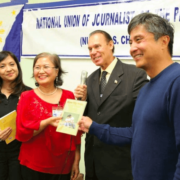Yards and yards of written papers spilled into violent paragraphs. There were pitiless accusations and vehement invectives that tried to open the eyes of those who do not want to see, unplug the ears of those who do not want to listen and ignite the thoughts of those who do not want to think.
It has been four years since the ignominy of a conscious and premeditated crime was carried out. 58 people, (32 of them media workers) were slaughtered on a hill top in Sitio Masalay, Barangay Salman in Ampatuan, Maguindanao in what is now acknowledged as the worst incident of electoral violence in recent Philippine history, and the single deadliest attack on the media on record.
Four years later, an injustice remains like a thorn pierced in the brains and hearts of the families and friends of those who died. They suffer physical sorrow that lacerates: bitter and acrimonious.
There comes a moment in life when keeping silent becomes a fault on a road of contempt, and speaking an obligation becomes a civic duty.
Call it righteous indignation, but there’s a lot of angry people that sympathize with the victims, especially from the media.
Touching episodes took place in the National Union of Journalists of the Philippines-USA Chapter (NUJP-USA) gathering, spearheaded by the intrepid Nimfa Rueda (who insists there is no hierarchy in this group, but just a circle of media people bound by the same ideals and mission.)
There were polemics, discussions of uncomfortable truths (that most of us already know, but not dare to express). Like messengers of paucity,we were seduced by the artist and their heart-rending patriotic songs, poetry and music.
In tears, a writer/lawyer said she will personally prosecute and support the case.
I don’t swim in an ocean of health but the moribund of my kind right there, made a covenant. It will not be limited to “I am here, I am here.”
As the national anthem was played, the journalists, who love our flags, placed their right hand over their hearts to salute the flag.
Then, all of a sudden, some newshens started to cry, in a silent, composed way — no moans, no hiccups.
My throat chokes a little, but I cry more than those who cry with tears in times like this. More often, the words I write are nothing but tears.
Journalists travel to where their stories lead them, which often take them into dangerous locations, in order to bring news stories to the public and make them aware of what’s happening around them, so that they may make informed decisions.
As we mark the 4th anniversary of the single greatest massacre of journalists, let us take a few moments to remember lost lives and the lasting impact this tragedy has had on their families.
Let us never forget the ultimate sacrifices that these journalists (including the ones we lost to typhoon Haiyan ) have made for the public good.
This statement of Senator Yee on the Maguindanao massacre was sent to the NUJP-USA Chapter.
The message validates reportage as a very serious matter among journalists.
It is not an amusement, nor an outlet or relief. Written words can do a lot of good but if evil, they can hurt as much as heal.
That is why I never write rapidly. I never cast away. I am slow, cautious and unappeasable — never resembling those who are always satisfied with their products, as if their gall bladder expels ambrosia.
As lawyer/writer Alma Luna Reyes stated in the event: “More than the rhythm of the phrase, or the cadence of the page, or the sound of the words, journalists are driven by their civic duty — the moral challenge…and categorical imperative.”







